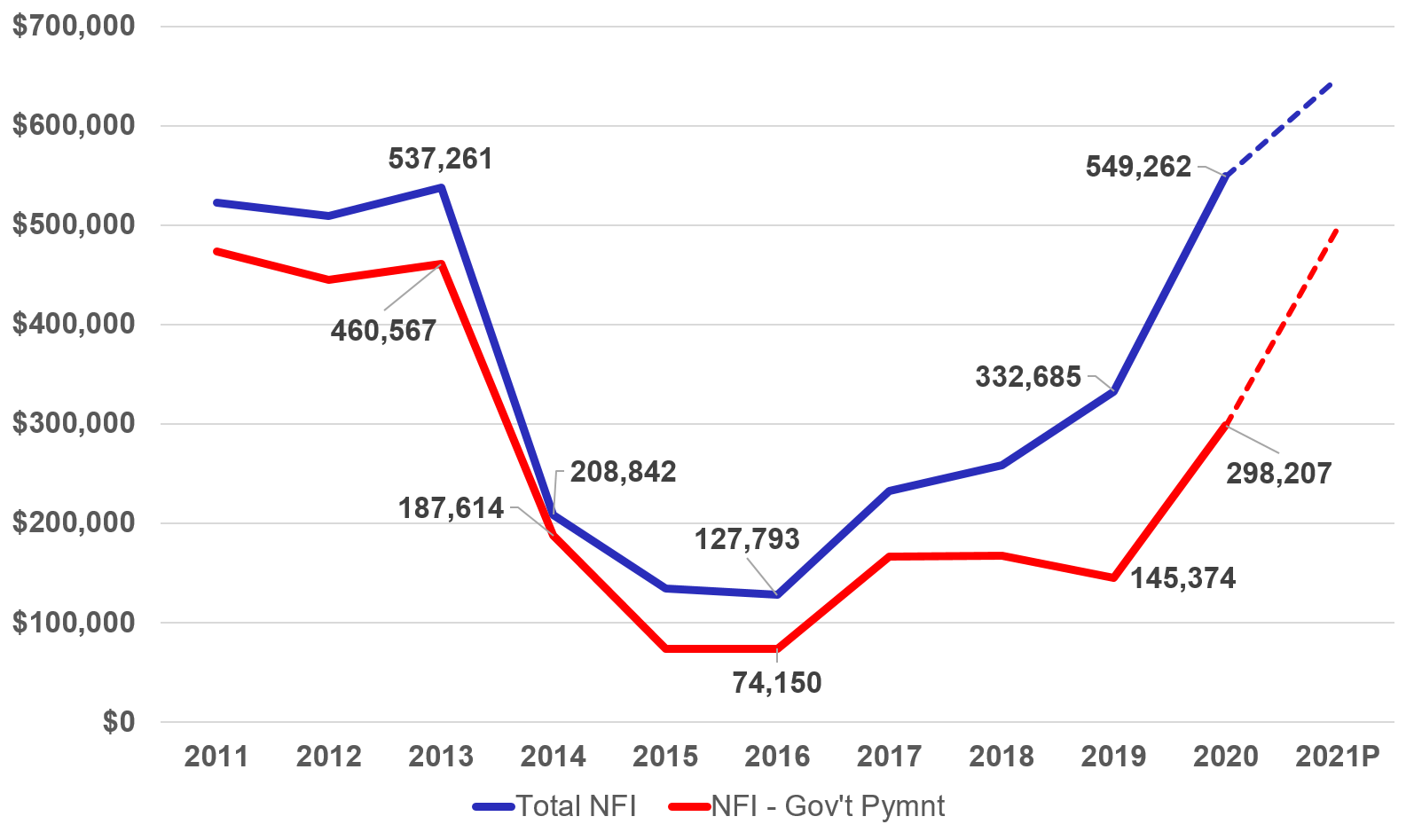Impact of Government Payments
Impact of Government Payments

How important is a new farm bill? That depends on a number of factors like what you grow, where you farm, and what happens during a year to trigger payment to you. What impact have farm bills and other government programs had on Kentucky farms in terms of profitability over the last decade? They appear to have had a considerable effect.
The graph shows Total Net Farm Income (NFI) for crop farms participating in the Kentucky Farm Business Management (KFBM) program between 2010 and 2020, and projections for 2021. Projections are based on USDA forecasts applied to average KFBM 2020 crop farms. The graph also shows Net Farm Income minus Government Payments. This represents net farm income from farm operating alone without government assistance. The gap between the two equals government payments.
The 2008 Farm Bill provided direct payments to farmers that supplemented high net farm income from farm operating alone. However, payments were critical to KFBM crop farms in 2010 suffering from late-season drought.
A new Farm Bill was not passed, so the 2008 bill was extended through 2013. A new farm bill went into effect in 2014 that replaced direct payments with payments based on price or revenue targets. The first payments were made in 2015. This left a void in government support programs for 2014. Unfortunately, commodity prices fell dramatically in 2014 and net farm income for KFBM crop farms fell 65% from a record high in 2013. Government payments averaged only $15,430 per farm, mostly from conservation programs.
Payments under the 2014 Farm Bill were critical as NFI from farming activities alone was slow to recover, remaining under $200,000 for KFBM through 2019. This was a turbulent time in agriculture as low revenue created a weakening of financial health and an increase in farm closures and bankruptcy.
Retaliatory tariffs on agricultural commodities from trade wars with China held back net income from farm operating in 2018 and 2019. Market Facilitation Program (MFP) payments offset the impacts of the tariffs in these years to help return crop farms to higher profitability by 2019. Average government payments from all programs, including MFP, grew to $187,311 for KFBM crop farms; 56% of Total NFI in 2019.
COVID-19 payments, existing government programs, and increased profitability from farming operations combined to push Total NFI to a record high in 2020. Average payments grew to $251,056 for farms participating in KFBM, but this represented only 45% of Total NFI. This does not include PPP loans and Employee Retention Credits. Total NFI is projected to be even higher for 2021, but government payments are projected to be 60% less without COVID-19 payments. These KFBM farms will receive about $100,000 less than in 2021, though the amount is still higher than the 10-year average.
Government programs have supported crop farm incomes most years. The lack of support was painfully apparent in 2014. Resumption of government payments provided underlying support during the following turbulent years. MFP contributed substantially to offset the impact of Chinese tariffs on agricultural commodities that were depressing farm income. COVID-19 programs further contributed to a rebound of Total NFI in 2020. The impact of farm bills and other government programs on farm profitability has been significant.
Figure 1: Difference Between Total Net Farm Income and
Net Farm Income - Government Payments

Recommended Citation Format:
Pierce, J. "Impact of Government Payments." Economic and Policy Update (22):2, Department of Agricultural Economics, University of Kentucky, February 28th, 2022.
Author(s) Contact Information:
